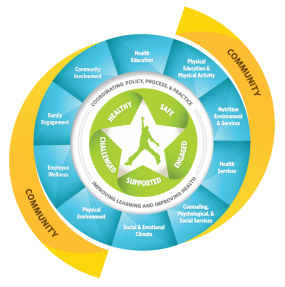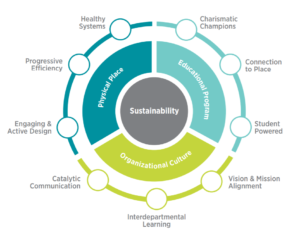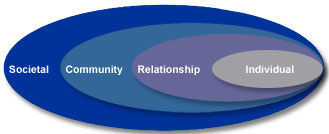Whole School, Whole Child, Whole Community & Other Theories that Inform Our Healthy Schools Work!
This month, we would like to take a deep dive into the theories that inform our public health practice. Theories help inform our work, guide our decision-making, and hold us accountable to a process that is equitable, inclusive, and responsible. When we’re thinking about improving the health, safety, and quality of the learning environments in our Pennsylvania schools, we want to be intentional in creating sustainable impacts and changing school cultures.
What does it mean when you say Healthy Schools is a public health program?
Public health is a discipline focused on preventing disease and promoting health for different populations of people. Instead of delivering care in a clinical setting, public health practitioners deliver care in a community setting. Instead of focusing on curing disease, public health practitioners spend most of their energy preventing disease through data collection, education, programming, and connecting families to resources. So when we say that Healthy Schools is a public health program, it means that we create programming that is based on the best available scientific evidence, that serves the entire school community, and that is focused on preventing environmental health hazards in the spaces where we grow, learn, play, and work.
Why do theories matter in public health programming?
Social and behavioral theories provide a framework for understanding why health disparities exist among different members in our communities. As an organization focused on protecting children’s health, we know that children are uniquely vulnerable to environmental hazards because of their developing bodies and behaviors. We want to reduce and eliminate the health risks so that children can have the best opportunity to thrive and grow.
For each theory below, we will break down its main components and discuss how we’re using theory to guide our principles in setting priorities and involving community members for Healthy Schools programming.
Whole School, Whole Child, Whole Community
According to the Centers for Disease Control, “The Whole School, Whole Community, Whole Child, or WSCC model, is CDC’s framework for addressing health in schools. The WSCC model is student-centered and emphasizes the role of the community in supporting the school, the connections between health and academic achievement and the importance of evidence-based school policies and practices. The WSCC model has 10 components:

- Physical education and physical activity.
- Nutrition environment and services.
- Health education.
- Social and emotional school climate.
- Physical environment.
- Health services.
- Counseling, psychological and social services.
- Employee wellness.
- Community involvement.
- Family engagement.
The Whole School, Whole Child, and Whole Community theory puts children’s health at the center. It focuses not only on what’s available to children – physical activity and health services, for example – but also what social supports are necessary for raising healthy children. Having other stakeholders involved, such as staff, teachers, parents, administrators, and community members really speaks to the proverb that ‘it takes a village to raise a child’. At Healthy Schools PA, we use this framework to map what assets and strengths are available to a specific school community, and which areas we need to invest and improve upon to support the health of the whole child, the whole school, and ultimately, the whole community!
Whole School Sustainability Framework
The Center for Green Schools, with other collaborative partners, first put forth the Whole School Sustainability Framework in 2016. According to the report, “The framework is founded on the imperative that in order to be successful, sustainability requires a whole-system approach.
A Whole-School Sustainability approach requires individuals from across an organization to work together—it cannot be accomplished in a silo. This system framework is organized into the three components of schools: organizational culture, physical place, and educational program. Within these three components, we have identified a total of nine principles. ”

At Healthy Schools PA, we know that in order to promote healthy schools, we also need to be thinking thoughtfully about what constitutes an environment. More than just the school building, learning environments are shaped by the relationships and systems within it – which is why we love the Whole School Sustainability Framework’s inclusion of Education Programs and Organizational Culture. Without support from school administrators and students, healthy schools are not possible. Not only do we want to create healthier learning environments for all students – we also want to promote a culture of sustainability where schools play an active role in resource conservation and environmental stewardship!
Socioecological Model
The last theory we’ll share is the Socioecological Model – a hallmark of community-based public health practice! The Socioecological Model shows how health happens at all levels in which our society is organized – at the individual, intra-personal (relationships), community, and societal levels.
On the Rural Health Information Hub, they explain the levels of this model below:
- Intrapersonal/individual factors, which influence behavior such as knowledge, attitudes, beliefs, and personality.
- Interpersonal factors, such as interactions with other people, which can provide social support or create barriers to interpersonal growth that promotes healthy behavior.
- Institutional and organizational factors, including the rules, regulations, policies, and informal structures that constrain or promote healthy behaviors.
- Community factors, such as formal or informal social norms that exist among individuals, groups, or organizations, can limit or enhance healthy behaviors.
- Public policy factors, including local, state, and federal policies and laws that regulate or support health actions and practices for disease prevention including early detection, control, and management.

We know that change does not happen in a vacuum. Change always happens in conversations within different systems in a school. The most effective public health programs work at all levels of the socioecological model. At Healthy Schools PA, we strive to cultivate individual relationships with school stakeholders, including parents, students, educators, and administrators. We train and educate community members on environmental health hazards, and we also advocate for societal or policy level solutions to protect children’s health!
Sources:
https://www.cdc.gov/healthyschools/wscc/index.htm
https://centerforgreenschools.org/sites/default/files/resource-files/Whole-School_Sustainability_Framework.pdf
https://www.ruralhealthinfo.org/toolkits/health-promotion/2/theories-and-models/ecological
